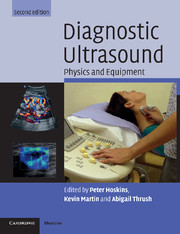Book contents
- Frontmatter
- Contents
- List of Contributors
- Preface to the second edition
- Preface to the first edition
- 1 Introduction to B-mode imaging
- 2 Physics
- 3 Transducers and beam-forming
- 4 B-mode instrumentation
- 5 Properties, limitations and artefacts of B-mode images
- 6 B-mode measurements
- 7 Principles of Doppler ultrasound
- 8 Blood flow
- 9 Spectral Doppler ultrasound
- 10 Colour flow and tissue imaging
- 11 Quality assurance
- 12 Safety of diagnostic ultrasound
- 13 3D ultrasound
- 14 Contrast agents
- 15 Elastography
- Appendices
- Glossary of terms
- Index
2 - Physics
Published online by Cambridge University Press: 06 July 2010
- Frontmatter
- Contents
- List of Contributors
- Preface to the second edition
- Preface to the first edition
- 1 Introduction to B-mode imaging
- 2 Physics
- 3 Transducers and beam-forming
- 4 B-mode instrumentation
- 5 Properties, limitations and artefacts of B-mode images
- 6 B-mode measurements
- 7 Principles of Doppler ultrasound
- 8 Blood flow
- 9 Spectral Doppler ultrasound
- 10 Colour flow and tissue imaging
- 11 Quality assurance
- 12 Safety of diagnostic ultrasound
- 13 3D ultrasound
- 14 Contrast agents
- 15 Elastography
- Appendices
- Glossary of terms
- Index
Summary
Introduction
Ultrasound is a high-frequency sound wave, which can be used to form images of internal body organs, as described briefly in the previous chapter. Ultrasound travels through the tissues of the body in a way which makes it possible to form useful images using relatively simple techniques, as described in Chapter 1. However, the image-formation process includes some approximations, which give rise to imperfections and limitations in the imaging system. In order to be able to use diagnostic ultrasound systems effectively and to be able to distinguish imperfections in the image from genuine diagnostic information, the user must have an appreciation of the basic principles of ultrasound propagation in tissue.
Waves
Transverse waves
A wave is a disturbance with a regularly repeating pattern, which travels from one point to another. A simple and familiar example is a wave on the surface of a pond caused by a stone being thrown into the water (Figure 2.1a). Here, water displaced by the stone causes a local change in the height of the water, which causes a change in height in the water immediately adjacent to it and so on. Hence a wave travels out from the point of entry of the stone. An important aspect of the nature of this wave is that it is only the disturbance which travels across the pond, and not the water.
- Type
- Chapter
- Information
- Diagnostic UltrasoundPhysics and Equipment, pp. 4 - 22Publisher: Cambridge University PressPrint publication year: 2010
- 5
- Cited by

